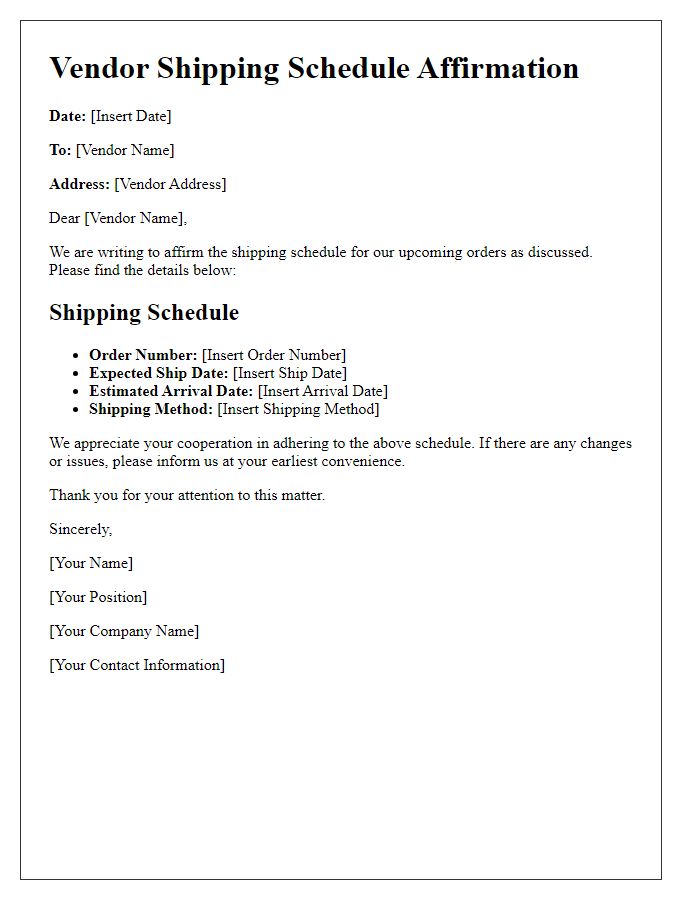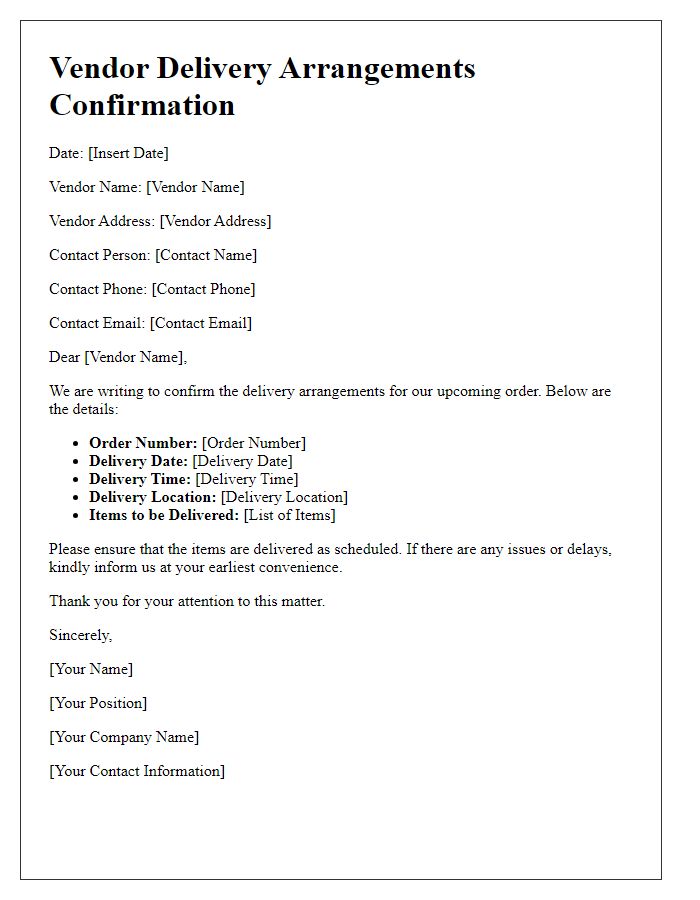Hey there! If you're looking to streamline your vendor delivery schedule, you're in the right place. Confirming delivery dates and times is key to ensuring smooth operations and maintaining strong supplier relationships. Let's dive into how a well-crafted letter can help you keep everything on trackâread on for tips and a sample template!

Vendor and client identification details
The vendor delivery schedule confirmation process involves crucial aspects such as vendor identification, including company name, contact information, and delivery capabilities. Client identification details should encompass the client's organization name, primary contact person, and specific delivery expectations. The delivery schedule must clearly outline critical logistics elements, such as delivery dates, times, locations, and any pertinent delivery instructions. Moreover, tracking information may need to be included, enabling clients to monitor their orders effectively. Timely communication between vendor and client can enhance operational efficiency, ensuring seamless order fulfillment and satisfactory service delivery.
Specific delivery date and time
The vendor delivery schedule confirmation ensures timely arrival of goods, notably essential for inventory management. Specific delivery dates, such as November 15, 2023, at 10:00 AM, allow businesses to prepare receiving protocols and allocate resources efficiently. Accurate timeframes minimize disruptions, enhancing operational productivity. Ensuring details like order numbers 23456 and tracking numbers AU123456789 allows for streamlined communication. For locations, such as the main warehouse at 123 Industrial Park, Springfield, timely updates prevent logistical challenges associated with unplanned delays.
Itemized list of goods or services
A vendor delivery schedule confirmation includes an itemized list of goods or services, detailing each product's specific name, quantity, and delivery date. For example, a shipment of 100 units of Widget A, scheduled for delivery on November 15, 2023, may be included, alongside 50 units of Gadget B, expected to arrive on the same date. This confirmation ensures that both parties--the vendor and the purchasing entity--are aligned on expectations and timelines. Additionally, critical information such as the shipping method (Ground, Air, etc.) and the receiving location, like Warehouse 5 at 123 Industry Lane, New York City, allows for efficient logistics planning. Each item may also include SKU numbers for easier tracking and inventory management.
Contact information for queries
Vendor delivery schedules require precise coordination to ensure timely arrivals and fulfill supply chain demands. Confirmation of delivery times helps mitigate any potential disruptions in logistics. For swift queries regarding delivery schedules or specific details, vendors can typically reach out via dedicated contact points such as customer service email addresses or hotline numbers. It's essential that vendors maintain updated and accessible contact information, allowing for immediate responses to any issues or changes in delivery timelines. The importance of effective communication cannot be overstated, as it supports operational efficiency in warehouses and retail environments alike.
Terms and conditions compliance
Vendor delivery schedules require strict adherence to terms and conditions outlined in contractual agreements. These conditions may include delivery timelines, quality standards, and packaging specifications. For instance, the delivery must arrive at the designated address (Warehouse #12, Industrial Park, City) by 3 PM on weekdays, ensuring timely processing within supply chain management. Non-compliance with agreed standards can result in penalties, affecting the overall procurement strategy and vendor relationships. It is critical for vendors to confirm their delivery capabilities and compliance with any mentioned regulations, such as environmental considerations or safety guidelines, to maintain a seamless flow of operations.













Comments